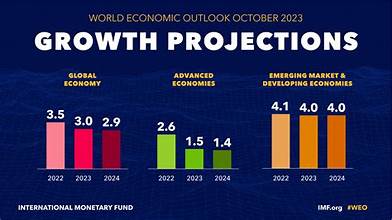
In 2024, the global economic landscape is shaped by dynamic policies that reflect both the aftermath of past crises and emerging opportunities for growth. Understanding these policies is crucial for businesses, investors, and policymakers aiming to navigate international trade effectively. This article explores the key economic policy trends of 2024 and their implications for global trade.
1. Global Economic Outlook in 2024
The global economy in 2024 is characterized by a complex interplay of recovery from the COVID-19 pandemic, geopolitical tensions, and technological advancements. While many economies are rebounding, the pace and sustainability of this recovery vary across regions. Central banks are grappling with the dual challenges of managing inflation and fostering growth. This environment creates both risks and opportunities for international trade.
1.1. Recovery from the Pandemic
The pandemic has left an indelible mark on global economies. Governments and international organizations are focusing on sustainable recovery strategies. This includes investing in green technologies, enhancing supply chain resilience, and addressing inequalities. These recovery strategies influence international trade by shaping demand patterns and altering global supply chains.
1.2. Geopolitical Tensions and Trade Relations
Geopolitical tensions, especially between major economies like the U.S., China, and the EU, continue to affect global trade dynamics. Trade policies, tariffs, and sanctions are frequently updated in response to shifting political landscapes. Businesses must stay informed about these changes to mitigate risks and capitalize on new opportunities.
2. Key Economic Policy Trends in 2024
2.1. Green Economy Initiatives
Environmental sustainability has become a central theme in economic policies. Many countries are implementing measures to combat climate change, such as carbon pricing, renewable energy incentives, and stricter environmental regulations. These policies are reshaping industries and influencing global trade patterns.
2.1.1. Carbon Pricing and Trade
Carbon pricing mechanisms, including carbon taxes and cap-and-trade systems, are gaining traction. These policies aim to internalize the cost of carbon emissions, influencing industries to adopt greener practices. For international trade, this means that businesses may face new costs and compliance requirements when trading with countries implementing carbon pricing.
2.1.2. Renewable Energy Investments
Investment in renewable energy sources is a priority for many governments. This shift is driving the growth of industries related to solar, wind, and hydro power. As countries transition to greener energy sources, trade in renewable technologies and related materials is expected to increase.
2.2. Digital Transformation and Trade
Digital transformation continues to revolutionize global trade. Technological advancements such as artificial intelligence, blockchain, and e-commerce platforms are reshaping how businesses operate and trade internationally.
2.2.1. E-Commerce Growth
The rise of e-commerce has democratized international trade, allowing businesses of all sizes to access global markets. In 2024, digital trade agreements and regulations are evolving to address issues such as data privacy, cross-border data flow, and digital taxation. These developments are crucial for businesses looking to expand their reach online.
2.2.2. Blockchain and Trade Efficiency
Blockchain technology is enhancing transparency and efficiency in international trade. By providing a secure and immutable ledger, blockchain reduces the risk of fraud and streamlines processes such as customs clearance and payment settlements. This technology is expected to gain further traction in 2024, facilitating smoother cross-border transactions.
2.3. Trade Agreements and Economic Blocs
Regional trade agreements and economic blocs play a significant role in shaping international trade policies. In 2024, several key agreements and blocs are influencing global trade dynamics.
2.3.1. The USMCA and NAFTA
The United States-Mexico-Canada Agreement (USMCA) continues to impact trade within North America. This agreement introduces new provisions on labor standards, environmental protection, and digital trade, affecting how businesses operate and trade in the region.
2.3.2. The EU Green Deal
The European Union’s Green Deal is a comprehensive policy framework aimed at achieving carbon neutrality by 2050. This deal influences trade by setting stringent environmental standards and promoting green technologies. Companies trading with the EU must adapt to these regulations to remain competitive.
2.3.3. The RCEP and Asia-Pacific Trade
The Regional Comprehensive Economic Partnership (RCEP) is a major trade agreement involving Asia-Pacific countries. It aims to reduce tariffs, enhance trade facilitation, and promote economic integration. The RCEP is expected to boost trade flows within the region and impact global supply chains.
3. Implications for International Trade
3.1. Supply Chain Resilience
Economic policies in 2024 emphasize building resilient supply chains. Companies are diversifying their supply sources and investing in technologies to enhance supply chain visibility. This shift is crucial for managing disruptions and ensuring the smooth flow of goods across borders.
3.2. Trade Barriers and Market Access
Trade barriers, such as tariffs and non-tariff measures, remain a concern for international trade. Businesses must navigate these barriers while seeking opportunities in emerging markets. Understanding regional trade policies and aligning with local regulations is essential for accessing new markets.
3.3. Investment Opportunities
Economic policies are creating new investment opportunities in sectors such as renewable energy, technology, and sustainable agriculture. Investors and businesses should identify and leverage these opportunities to gain a competitive edge in the global market.
4. Conclusion
Navigating global economic policies in 2024 requires a keen understanding of emerging trends and their impact on international trade. Green economy initiatives, digital transformation, and evolving trade agreements are reshaping the global trade landscape. By staying informed and adapting to these changes, businesses and investors can effectively navigate the complexities of the global market and seize new opportunities for growth.

